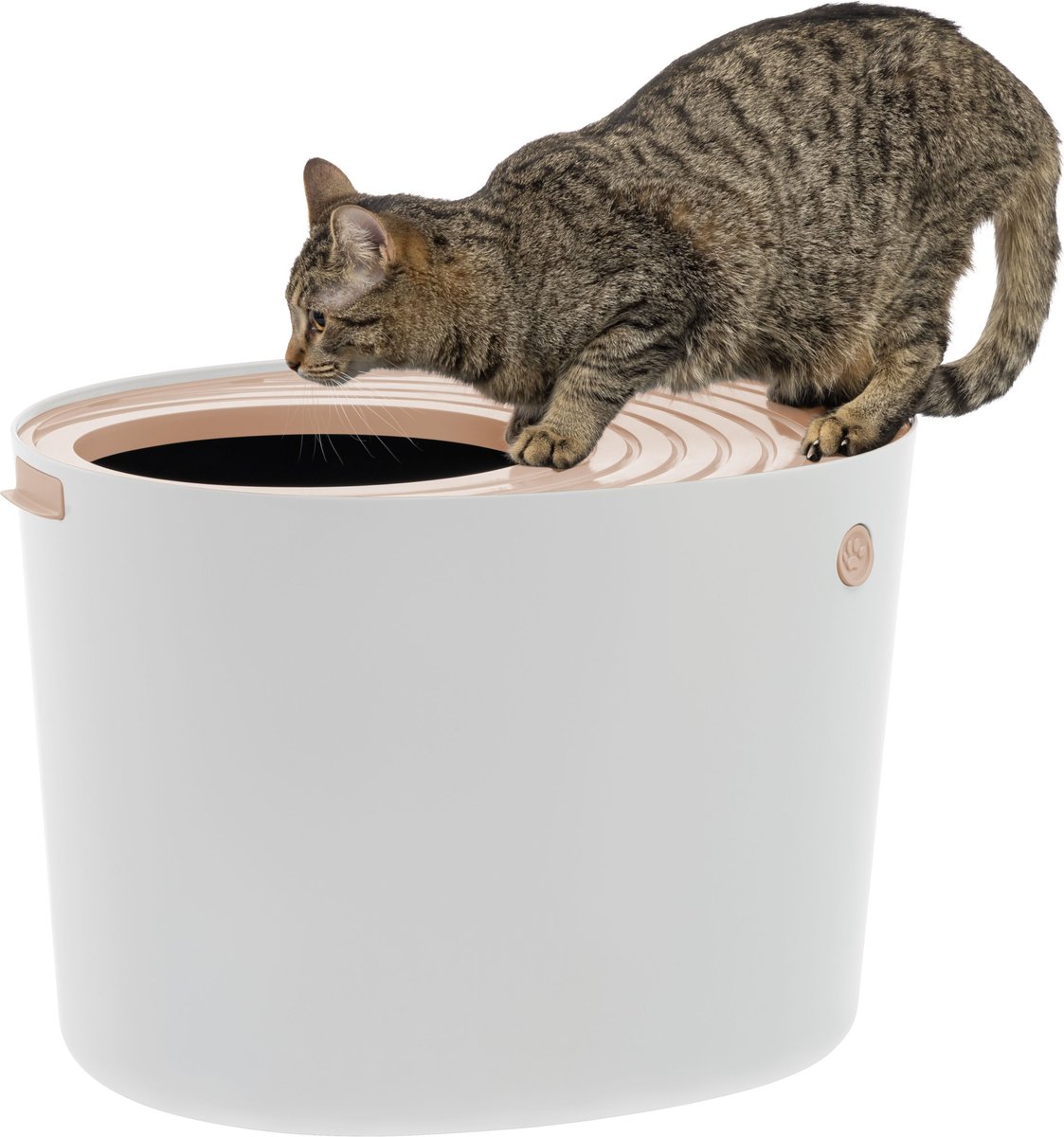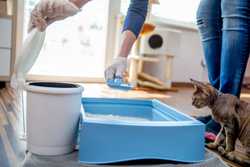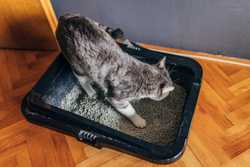How to Train a Kitten to Use a Litter Box, According to a Veterinarian

Our evaluations and opinions are not influenced by our advertising relationships, but we may earn a commission from our partners’ links. This content is created by TIME Stamped, under TIME’s direction and produced in accordance with TIME’s editorial guidelines and overseen by TIME’s editorial staff. Learn more about it.
Welcoming a kitten (or kittens!) into your home is exciting. Whether this is your first cat—or your first time having to train one—it’s helpful to know there are practical steps to make things easier on you and your kitten. If you’re feeling unsure, that’s understandable. I’ve outlined dos and don’ts to help take the mystery out of litter box training.
Kittens can be litter box trained around the time they’re weaned, which is about four weeks of age. If you have an older kitten who isn’t litter box trained, start training when you bring them home.
For adult cats, it’s best to have boxes that are 1.5 times their body length but for kittens that’s too big and might make them think of cartoon-quicksand. While training—and until your cat is older—provide smaller litter boxes that are only about a foot long.
You might have to do some trial and error with litter. Just like we have preferences with things in life, cats do too. Cats like litter that resembles sand, such as clay litter. Clumping litter is easy to clean up but stick to unscented. Cats have a sensitive sense of smell and their noses are a lot closer to the litter than yours.
If you're new to the world of cats, a litter box scoop is a must. It’s kind of like a slotted spoon and it makes scooping out clumps of urine and solid waste easy. I prefer scoops that come with a holder or stand, like toilet bowl cleaners do, because otherwise, well, eww.
The general rule is that you should have one more litter box than the number of cats, so a one cat home should have two litter boxes. A home with two cats should have three litter boxes, and so on. There are exceptions where you might need more, such as for large and multilevel homes where you should have at least one box per floor, so your kitten doesn’t have to ‘hold it’ while on a trek to a litter box.

Regardless of if you live in a house or an apartment, litter boxes should be somewhere easy for your kitten to access, like a room where they hang out or sleep. Place them in areas away from lots of traffic, noisy appliances, and distractions. The living room, a home office, and your bedroom are good locations as long as the door is always open and these rooms are familiar to your kitten, such as a place where they play or nap.
The boxes should be in more open areas so your kitten can feel like they’re able to escape if approached by another pet in the home, or if they’re startled by a sound. Even if your cat lives without other pets, a litter box in a spacious area makes them feel more safe. As tempting as it might be to tuck the box into a corner because they fit together like puzzle pieces, it’s best to have the box away from the wall so it doesn’t have that cornered feel. Open areas also tend to be more well ventilated (which reduces litter box odors) and well lit, which helps kitties feel safe because of the increased visibility of their surroundings. You can read more about location in my guide, where to put your cat’s litter box.
Even though apartment sizes vary considerably, place litter boxes in larger areas (living room, bedroom, even hallways), at least while training, even if it means they’re more out in the open. The bathroom is an option for a litter box but if you choose this location make sure to scoop the box at least once a day to keep down odors since humidity can increase smell.
When your kitten gets used to using a litter box, you can move the boxes to where it’s more convenient if necessary—and of course you’ll be a good cat butler and show them the new location of their boxes. But the location still needs to be convenient for your cat. And don’t plan on doing this soon after they’ve been trained. Wait a few months to let them become litter box experts.
After your kitten is trained, if needed due to space, a closet or unused cabinet (that can be kept open at all times) is an option but some cats might not like these areas because it’s not spacious. The feeling of potentially being trapped while being in a vulnerable position can cause some cats to refuse to use these locations, even if they live without other animals. Ventilation, odors, and lighting can be problematic as well.
There are also a variety of cat furniture options but realize that cats often prefer open boxes. When training kittens, I suggest skipping cat furniture and enclosed boxes for several reasons. They’re enclosed spaces which can feel intimidating, in addition to being low light and having increased odors due to reduced ventilation—and young kittens can have trouble getting in and out of them.
When training a kitten, it’s best to have at least one litter box on each floor. On upper level floors, try to pick rooms that your cat spends time in, like a bedroom they sleep in at night. On the lower level, consider rooms like the living room if your cat hangs out there during the day. Avoid high traffic areas.

Step 1: Introduce your kitten to all the litter box locations. This can be a lot to take in depending on how many boxes there are. If you have a multi-level home and your kitten will initially spend more time on a particular floor during the day (e.g. with someone working from a home office or with someone near or in the living room), introduce them to the daytime boxes during the day. If your kitten will be sleeping with one of his or her humans at night, introduce them to those boxes at night.
Step 2: Place your kitten in the litter box. They may or may not instinctively use it, and if they don’t, paw at the litter with your hand to show them how it’s done.
Step 3: Take your kitten to their litter box after naps and meals until they learn to go there on their own. It also helps to reward them with a little treat immediately after they get out of the litter box.
If your kitten won’t use their litter box, common reasons include location of the box, the type of box or the type of litter (or both), cleanliness of the box, and stressful dynamics with other cats in the household. If you feel like you’ve addressed these issues and still have questions, consult with your veterinarian.
Make sure the litter boxes aren’t in noisy or high traffic locations, such as around the kitchen or near appliances like the washer and dryer. The litter boxes should also not be next to your kitten’s sleep areas or food and water bowls (though they can be on the opposite side of the same room) but they should be in areas that are easy to access for a kitten. Don’t expect your kitten to take a long trip, such as up the stairs to another level. Areas that are dimly lit, poorly ventilated, in a corner, or that sometimes have the door closed can also deter a kitten from using it.
Can your kitten easily get in and out of the box? Is the box appropriately sized for a kitten (meaning about a foot long and not much larger)? Finding the best litter box (and litter) for your kitten may take some trial and error.
Though it might be tempting to get your kitten used to a self-cleaning litter box right away, for initial litter box training my suggestion is to keep it simple: an open-top box that’s kitten-size. Some self cleaning litter boxes are enclosed and for a kitten getting used to using a litter box, you want them to feel safe. Part of that includes being able to see all around them when in a vulnerable position, which they can’t do in an enclosed box. But if you want to plan on a self-cleaning box for the future, read our Litter-Robot 4 review.
Is the litter scented? Cats have a sensitive sense of smell and they prefer unscented litter. Is the litter uncomfortable for your kitten’s paws? Cats prefer the grainy, soft feel of sand-like litter. They also don’t like litter that smells like food, such as corn cob litter. Are you using silica litter? Some cats don’t like the texture of it and kittens might find it uncomfortable on and between their little paw pads.
Keep the litter box as clean as possible, scooping it a couple times a day and dumping out all the litter and washing the box with warm soapy water—no bleach or vinegar because of their strong smells—once every one to two weeks. To learn more, read our guide on how often to clean a litter box.
If you have adult cats, they might be territorial and anxious about suddenly having to share their litter box, rest areas, and other key resources like food and water bowls. If you have an adult cat that is being a bully, try adding more boxes in areas where your kitten hangs out. Feline pheromone diffusers can also help reduce anxiety.
Accidents are a natural part of litter box training and an animal should not be punished for urinating or defecating on the floor. However, these areas should be cleaned with an enzymatic pet cleaner like Nature’s Miracle to remove the smell, so your kitten doesn’t keep using that location. If they’re going in a place where it would be convenient to place a litter box, then do so.
Litter box training might sound intimidating at first but there are practical steps that can help you and your kitten learn what to do. Opt for unscented, sand-like litter in smaller, open-top litter boxes that are easy for your kitten to access. And keep the boxes scooped regularly. If you have trouble with litter box training, consult your veterinarian.
The information presented here is created by TIME Stamped and overseen by TIME editorial staff. To learn more, see our About Us page.



